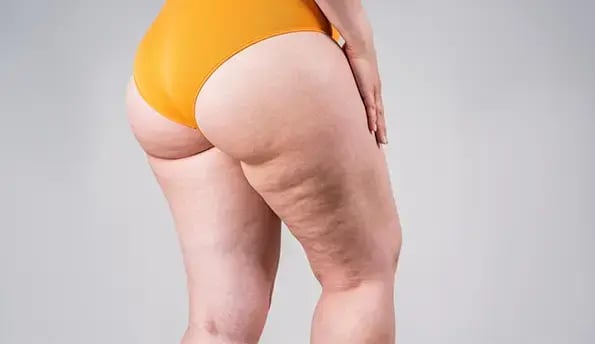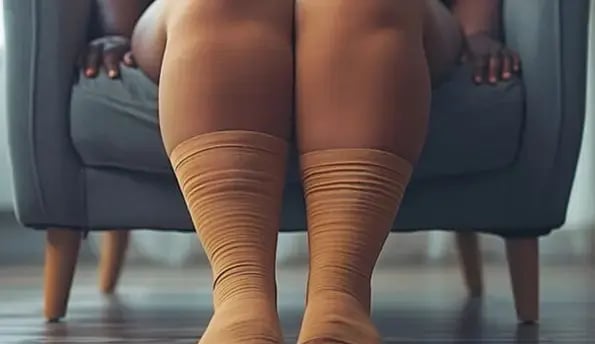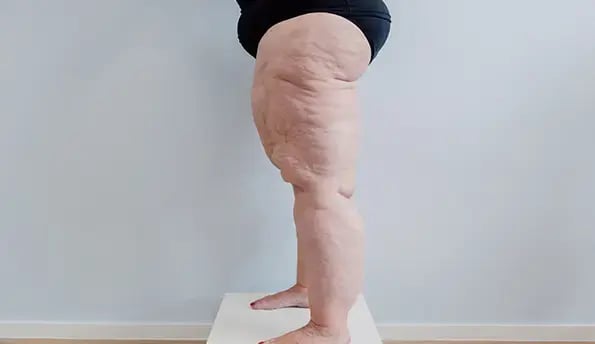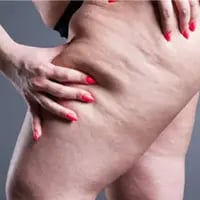What Is Lipedema and How Does It Differ from Cellulite?
What Causes Lipedema and Cellulite?
Lipedema is a condition where fat builds up abnormally in your lower body. It affects mainly women, with up to 11% of women having this condition. Lipedema typically starts in the buttocks and legs. While it might seem like just a cosmetic issue at first, it can eventually cause pain and other problems.

Lipedema vs. Cellulite
Lipedema vs. Lymphedema
Lipedema can be mistaken for obesity or another condition called lymphedema. Your body's lymphatic system helps protect you against infections by moving a fluid called lymph. Lymphedema happens when this lymph fluid builds up because the lymph vessels or nodes are damaged or missing. This buildup causes swelling.
While both lipedema and lymphedema cause swelling, lipedema is not due to lymph buildup. However, lipedema can lead to lymphedema over time. In lipedema, fat cells can block the lymph vessels, preventing proper lymph drainage. This can result in lymphedema, which can cause infections, delayed wound healing, fibrosis (scar-like tissue), and hardened skin in the legs.
Unlike lymphedema, lipedema usually starts in the upper legs, not the lower legs, feet, or ankles. Lipedema also isn't related to previous surgeries. It usually affects both legs equally.
Our mission is to create a world where every investment in modern beauty is Worth It.
Let's keep in touch
Get updates of the treatments you are interested
Stages of Lipedema
Types of Lipedema
Lipedema is classified into different types based on where the fat tissue builds up:
Type I: Fat collects around your hips and buttocks.
Type II: Fat builds up between your hips and knees.
Type III: Fat is found between your hips and ankles.
Type IV: Fat collects in your arms.
Type V: Fat builds up in your calves.
You can have more than one type of lipedema at the same time. For example, Type IV, which involves fat buildup in the arms, is rare and usually happens along with Type II or III, which involve the lower body.

Treatment Options
There are several treatments available for lipedema:
- Manual Lymphatic Drainage (MLD): This is a type of massage that helps move lymph fluid through the body. It can reduce swelling and discomfort.
- Compression Garments: These are tight-fitting clothes that help prevent fluid buildup and reduce swelling.
- Liposuction: This surgical procedure removes fat from the body. It can help reduce the size of the affected areas and relieving pain.
- Healthy Diet and Exercise: While diet and exercise alone can't cure lipedema, maintaining a healthy lifestyle can help manage symptoms and improve overall health.
Living with Lipedema
Living with lipedema can be challenging, but there are ways to manage the condition. It's important to work with a healthcare professional to develop a treatment plan that works for you. Staying active, eating a healthy diet, and wearing compression garments can help manage symptoms and improve your quality of life.
In summary, lipedema is a condition where fat builds up abnormally in the lower body, affecting mainly women. It can be mistaken for other conditions like cellulite or lymphedema, but it has its unique characteristics. Lipedema can cause pain and other complications, but with early detection and proper treatment, its progression can be slowed, and symptoms can be managed effectively.
What are the Symptoms of Lipedema?
Lipedema is a condition that causes abnormal fat buildup, mainly in the lower body. Here are the typical symptoms:
- Difference in Size of Feet and Legs: One clear sign of lipedema is the noticeable size difference between your feet and your legs. Your feet stay their normal size, but your legs become much larger. For example, the top half of your body might be a size 8, but your bottom half could be a size 16. This is because lipedema affects the legs and lower body, making them look like columns.
- Pain: Lipedema can be painful. This pain might be constant or only felt when you press on the affected areas. Your skin may also bruise easily and feel tender.
- Heavy Feeling and Swelling: People with lipedema often feel a heavy sensation in their legs, and they may experience swelling. This swelling isn't due to fluid but the abnormal buildup of fat.
- A buildup of Fat: As lipedema progresses, more fat builds up in the affected areas. Initially, it affects the legs, but it can also spread to the arms over time.
- Loose Skin: The buildup of fat can cause large folds of skin to form. This can make the skin look and feel different.
- Bumps Under the Skin: Lipedema fat often has a lumpy texture. These bumps feel like something is under the skin.
- Fatigue: People with lipedema often feel more tired than usual. This constant tiredness can affect daily activities.
Our mission is to create a world where every investment in modern beauty is Worth It.
Let's keep in touch
Get updates of the treatments you are interested
Why Does Lipedema Fat Hurt?
What Causes Lipedema?
The exact cause of lipedema is still unknown, but several factors might contribute to its development:
1. Hormones: Doctors think hormones play a significant role in lipedema because the condition mostly affects women. It often begins or gets worse at times when women's hormone levels change, like during puberty, pregnancy, after gynecologic surgery, around menopause, or when taking birth control pills.
2. Genes: There seems to be a genetic link to lipedema. Many women with lipedema (20% to 60%) have family members who also have the condition. This suggests that genes might be involved in developing lipedema.
3. Obesity: While obesity is not a direct cause of lipedema, many people with the condition have a higher body mass index (BMI) over 35. However, lipedema is not caused by being overweight, and losing weight doesn't cure it.
Managing Lipedema
Lipedema is a long-term condition, but there are ways to manage it. Here are some strategies:
1. Healthy Diet: Eating a balanced diet can help manage your overall health and may reduce some symptoms.
2. Exercise: Regular low-impact exercise, like walking or swimming, can help improve circulation and reduce some of the heaviness in your legs.
3. Compression Garments: Wearing compression stockings or sleeves can help reduce swelling and discomfort.
4. Manual Lymphatic Drainage (MLD): This is a special type of massage that can help move lymph fluid through your body and reduce swelling.
5. Liposuction: In some cases, liposuction can remove the abnormal fat buildup and provide relief from symptoms.
6. Support: Joining a support group or talking to others with lipedema can provide emotional support and practical advice for managing the condition.
Our mission is to create a world where every investment in modern beauty is Worth It.
Let's keep in touch
Get updates of the treatments you are interested
Lipedema Diagnosis
Lipedema is sometimes mistaken for other conditions because its symptoms are similar. There's no single test for diagnosing lipedema. Instead, a doctor will look at your medical history and do a physical exam, which includes checking the texture of the affected areas.
Your doctor will look for specific signs of lipedema, such as:- Enlargement in both legs (but not the feet).
- Pain or tenderness when pressure is applied.
- Easy bruising.
They may also use the “Stemmer sign” by pinching the skin over your second toe. If the skin is thick and hard to lift, it might be lymphedema, not lipedema.
Your doctor may order tests like MRI, CT scan, ultrasound, DEXA scan, or nuclear medicine imaging to help diagnose lipedema.
Stages of Lipedema
Lipedema progresses through four stages:
- Stage 0: No visible swelling, but you might feel general aches and heaviness.
- Stage 1: Skin looks normal but feels like there’s something underneath.
- Stage 2: Skin looks uneven, bumpy, or dimpled.
- Stage 3: Large folds of skin and fat, making your legs look like rectangular balloons. Movement can become difficult.
- Stage 4: Both lipedema and lymphedema are present, with swelling in the lower body and sometimes the arms.

Lipedema Treatments
There's no cure for lipedema, but treatments can help improve symptoms:
- Exercise and Healthy Diet: Lifestyle changes, such as a heart-healthy or anti-inflammatory diet, can help. Exercise can improve lymph flow.
- Compression: Devices like pneumatic compression garments and compression stockings can reduce pain and improve symptoms.
- Skin Moisturizer: Helps prevent skin dryness.
- Medications and Supplements: Some medications and supplements, like selenium and resveratrol, can help manage symptoms.
- Liposuction: Water-assisted and tumescent liposuction can remove lipedema fat and reduce pain. Multiple sessions may be needed.
- Bariatric Surgery: This can help reduce leg volume in some people with lipedema.
- Complete Decongestive Therapy: This includes:
- Manual Lymphatic Drainage: A gentle massage to help lymph fluid move to healthy areas.
- Compression: Using stretch bandages or custom garments to prevent fluid buildup.
- Exercise: Helps reduce fluid buildup and improve leg function.
- Skin and Nail Care: Reduces the risk of wounds and infections.
Unlike regular fat, lipedema fat is resistant to weight loss from diet, exercise, or bariatric surgery. This means that typical weight loss methods might not work on lipedema fat.
Our mission is to create a world where every investment in modern beauty is Worth It.
Let's keep in touch
Get updates of the treatments you are interested
Lipedema Complications
Lipedema can make it hard to walk and move because of the fat buildup in your legs. This can also block your lymphatic system, causing a condition called lipo-lymphedema, where you have both lipedema and lymphedema.
The extra fat from lipedema can cause joint problems, like knock knees, and might lead to flat feet and vein issues.
Lipedema doesn’t just cause physical problems. It can also affect your mental health. Many people with lipedema feel depressed, anxious, or embarrassed about their appearance. This can make it hard to enjoy life.

Lipedema FAQs
How Do You Know If You Have Lipedema?
There isn’t a single test that can tell if you have lipedema. Instead, a doctor will ask about your medical history and do a physical exam. They may feel the texture of your skin and the areas affected.
How Do I Know If I Have Lipedema or Just Fat?
Lipedema is different from regular body fat. It can be painful and feels uneven under the skin. With lipedema, you’ll notice a big difference between the size of the affected areas and the unaffected areas. For example, your upper body might be a lot smaller than your lower body.
Can You Lose Lipedema Fat?
Lipedema fat is hard to lose with regular diet and exercise. More invasive treatments, like liposuction and bariatric surgery, can remove this fat. Other treatments, like an exercise program and wearing compression stockings, can help manage the symptoms of lipedema.
Can Lipedema Be Corrected?
There is no cure for lipedema. For some people, lipedema is mild and doesn’t get worse. For others, it can worsen over time. Getting an early diagnosis can help prevent complications and make managing the condition easier.
What Causes Lipedema and Cellulite?
Lipedema is a condition where fat builds up abnormally in your lower body. It affects mainly women, with up to 11% of women having this condition. Lipedema typically starts in the buttocks and legs. While it might seem like just a cosmetic issue at first, it can eventually cause pain and other problems.

Lipedema vs. Cellulite
Lipedema vs. Lymphedema
Lipedema can be mistaken for obesity or another condition called lymphedema. Your body's lymphatic system helps protect you against infections by moving a fluid called lymph. Lymphedema happens when this lymph fluid builds up because the lymph vessels or nodes are damaged or missing. This buildup causes swelling.
While both lipedema and lymphedema cause swelling, lipedema is not due to lymph buildup. However, lipedema can lead to lymphedema over time. In lipedema, fat cells can block the lymph vessels, preventing proper lymph drainage. This can result in lymphedema, which can cause infections, delayed wound healing, fibrosis (scar-like tissue), and hardened skin in the legs.
Unlike lymphedema, lipedema usually starts in the upper legs, not the lower legs, feet, or ankles. Lipedema also isn't related to previous surgeries. It usually affects both legs equally.
Our mission is to create a world where every investment in modern beauty is Worth It.
Let's keep in touch
Get updates of the treatments you are interested
Stages of Lipedema
Types of Lipedema
Lipedema is classified into different types based on where the fat tissue builds up:
Type I: Fat collects around your hips and buttocks.
Type II: Fat builds up between your hips and knees.
Type III: Fat is found between your hips and ankles.
Type IV: Fat collects in your arms.
Type V: Fat builds up in your calves.
You can have more than one type of lipedema at the same time. For example, Type IV, which involves fat buildup in the arms, is rare and usually happens along with Type II or III, which involve the lower body.
Symptoms and Complications
Treatment Options
There are several treatments available for lipedema:
- Manual Lymphatic Drainage (MLD): This is a type of massage that helps move lymph fluid through the body. It can reduce swelling and discomfort.
- Compression Garments: These are tight-fitting clothes that help prevent fluid buildup and reduce swelling.
- Liposuction: This surgical procedure removes fat from the body. It can help reduce the size of the affected areas and relieving pain.
- Healthy Diet and Exercise: While diet and exercise alone can't cure lipedema, maintaining a healthy lifestyle can help manage symptoms and improve overall health.
Living with Lipedema
Living with lipedema can be challenging, but there are ways to manage the condition. It's important to work with a healthcare professional to develop a treatment plan that works for you. Staying active, eating a healthy diet, and wearing compression garments can help manage symptoms and improve your quality of life.
In summary, lipedema is a condition where fat builds up abnormally in the lower body, affecting mainly women. It can be mistaken for other conditions like cellulite or lymphedema, but it has its unique characteristics. Lipedema can cause pain and other complications, but with early detection and proper treatment, its progression can be slowed, and symptoms can be managed effectively.
What are the Symptoms of Lipedema?
Lipedema is a condition that causes abnormal fat buildup, mainly in the lower body. Here are the typical symptoms:
- Difference in Size of Feet and Legs: One clear sign of lipedema is the noticeable size difference between your feet and your legs. Your feet stay their normal size, but your legs become much larger. For example, the top half of your body might be a size 8, but your bottom half could be a size 16. This is because lipedema affects the legs and lower body, making them look like columns.
- Pain: Lipedema can be painful. This pain might be constant or only felt when you press on the affected areas. Your skin may also bruise easily and feel tender.
- Heavy Feeling and Swelling: People with lipedema often feel a heavy sensation in their legs, and they may experience swelling. This swelling isn't due to fluid but the abnormal buildup of fat.
- A buildup of Fat: As lipedema progresses, more fat builds up in the affected areas. Initially, it affects the legs, but it can also spread to the arms over time.
- Loose Skin: The buildup of fat can cause large folds of skin to form. This can make the skin look and feel different.
- Bumps Under the Skin: Lipedema fat often has a lumpy texture. These bumps feel like something is under the skin.
- Fatigue: People with lipedema often feel more tired than usual. This constant tiredness can affect daily activities.
Our mission is to create a world where every investment in modern beauty is Worth It.
Let's keep in touch
Get updates of the treatments you are interested
Why Does Lipedema Fat Hurt?
What Causes Lipedema?
The exact cause of lipedema is still unknown, but several factors might contribute to its development:
1. Hormones: Doctors think hormones play a significant role in lipedema because the condition mostly affects women. It often begins or gets worse at times when women's hormone levels change, like during puberty, pregnancy, after gynecologic surgery, around menopause, or when taking birth control pills.
2. Genes: There seems to be a genetic link to lipedema. Many women with lipedema (20% to 60%) have family members who also have the condition. This suggests that genes might be involved in developing lipedema.
3. Obesity: While obesity is not a direct cause of lipedema, many people with the condition have a higher body mass index (BMI) over 35. However, lipedema is not caused by being overweight, and losing weight doesn't cure it.
Managing Lipedema
Lipedema is a long-term condition, but there are ways to manage it. Here are some strategies:
1. Healthy Diet: Eating a balanced diet can help manage your overall health and may reduce some symptoms.
2. Exercise: Regular low-impact exercise, like walking or swimming, can help improve circulation and reduce some of the heaviness in your legs.
3. Compression Garments: Wearing compression stockings or sleeves can help reduce swelling and discomfort.
4. Manual Lymphatic Drainage (MLD): This is a special type of massage that can help move lymph fluid through your body and reduce swelling.
5. Liposuction: In some cases, liposuction can remove the abnormal fat buildup and provide relief from symptoms.
6. Support: Joining a support group or talking to others with lipedema can provide emotional support and practical advice for managing the condition.
Our mission is to create a world where every investment in modern beauty is Worth It.
Let's keep in touch
Get updates of the treatments you are interested
Lipedema Diagnosis
Lipedema is sometimes mistaken for other conditions because its symptoms are similar. There's no single test for diagnosing lipedema. Instead, a doctor will look at your medical history and do a physical exam, which includes checking the texture of the affected areas.
Your doctor will look for specific signs of lipedema, such as:- Enlargement in both legs (but not the feet).
- Pain or tenderness when pressure is applied.
- Easy bruising.
They may also use the “Stemmer sign” by pinching the skin over your second toe. If the skin is thick and hard to lift, it might be lymphedema, not lipedema.
Your doctor may order tests like MRI, CT scan, ultrasound, DEXA scan, or nuclear medicine imaging to help diagnose lipedema.
Stages of Lipedema
Lipedema progresses through four stages:
- Stage 0: No visible swelling, but you might feel general aches and heaviness.
- Stage 1: Skin looks normal but feels like there’s something underneath.
- Stage 2: Skin looks uneven, bumpy, or dimpled.
- Stage 3: Large folds of skin and fat, making your legs look like rectangular balloons. Movement can become difficult.
- Stage 4: Both lipedema and lymphedema are present, with swelling in the lower body and sometimes the arms.

Lipedema Treatments
There's no cure for lipedema, but treatments can help improve symptoms:
- Exercise and Healthy Diet: Lifestyle changes, such as a heart-healthy or anti-inflammatory diet, can help. Exercise can improve lymph flow.
- Compression: Devices like pneumatic compression garments and compression stockings can reduce pain and improve symptoms.
- Skin Moisturizer: Helps prevent skin dryness.
- Medications and Supplements: Some medications and supplements, like selenium and resveratrol, can help manage symptoms.
- Liposuction: Water-assisted and tumescent liposuction can remove lipedema fat and reduce pain. Multiple sessions may be needed.
- Bariatric Surgery: This can help reduce leg volume in some people with lipedema.
- Complete Decongestive Therapy: This includes:
- Manual Lymphatic Drainage: A gentle massage to help lymph fluid move to healthy areas.
- Compression: Using stretch bandages or custom garments to prevent fluid buildup.
- Exercise: Helps reduce fluid buildup and improve leg function.
- Skin and Nail Care: Reduces the risk of wounds and infections.
Unlike regular fat, lipedema fat is resistant to weight loss from diet, exercise, or bariatric surgery. This means that typical weight loss methods might not work on lipedema fat.
Our mission is to create a world where every investment in modern beauty is Worth It.
Let's keep in touch
Get updates of the treatments you are interested
Lipedema Complications
Lipedema can make it hard to walk and move because of the fat buildup in your legs. This can also block your lymphatic system, causing a condition called lipo-lymphedema, where you have both lipedema and lymphedema.
The extra fat from lipedema can cause joint problems, like knock knees, and might lead to flat feet and vein issues.
Lipedema doesn’t just cause physical problems. It can also affect your mental health. Many people with lipedema feel depressed, anxious, or embarrassed about their appearance. This can make it hard to enjoy life.

Lipedema FAQs
How Do You Know If You Have Lipedema?
There isn’t a single test that can tell if you have lipedema. Instead, a doctor will ask about your medical history and do a physical exam. They may feel the texture of your skin and the areas affected.
How Do I Know If I Have Lipedema or Just Fat?
Lipedema is different from regular body fat. It can be painful and feels uneven under the skin. With lipedema, you’ll notice a big difference between the size of the affected areas and the unaffected areas. For example, your upper body might be a lot smaller than your lower body.
Can You Lose Lipedema Fat?
Lipedema fat is hard to lose with regular diet and exercise. More invasive treatments, like liposuction and bariatric surgery, can remove this fat. Other treatments, like an exercise program and wearing compression stockings, can help manage the symptoms of lipedema.
Can Lipedema Be Corrected?
There is no cure for lipedema. For some people, lipedema is mild and doesn’t get worse. For others, it can worsen over time. Getting an early diagnosis can help prevent complications and make managing the condition easier.






.webp?width=738&height=510&name=liposuction-min%20(1).webp)

